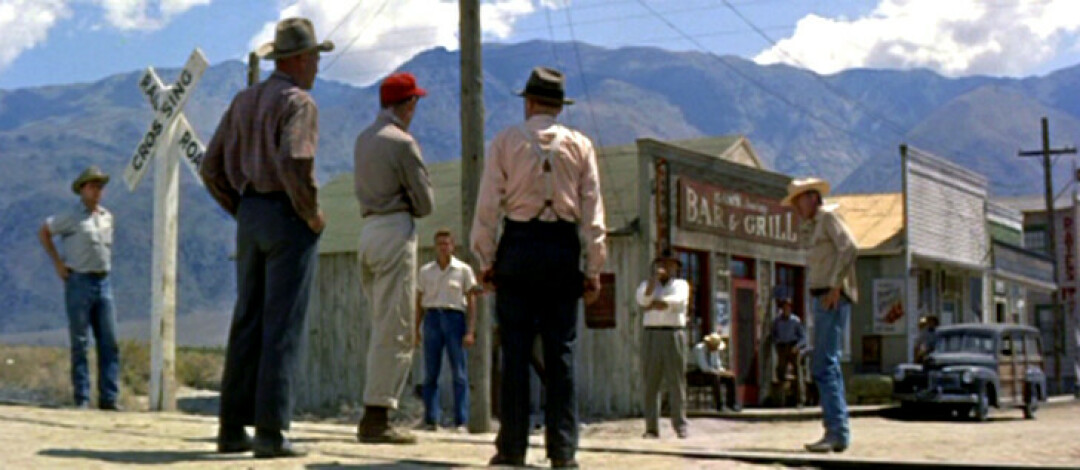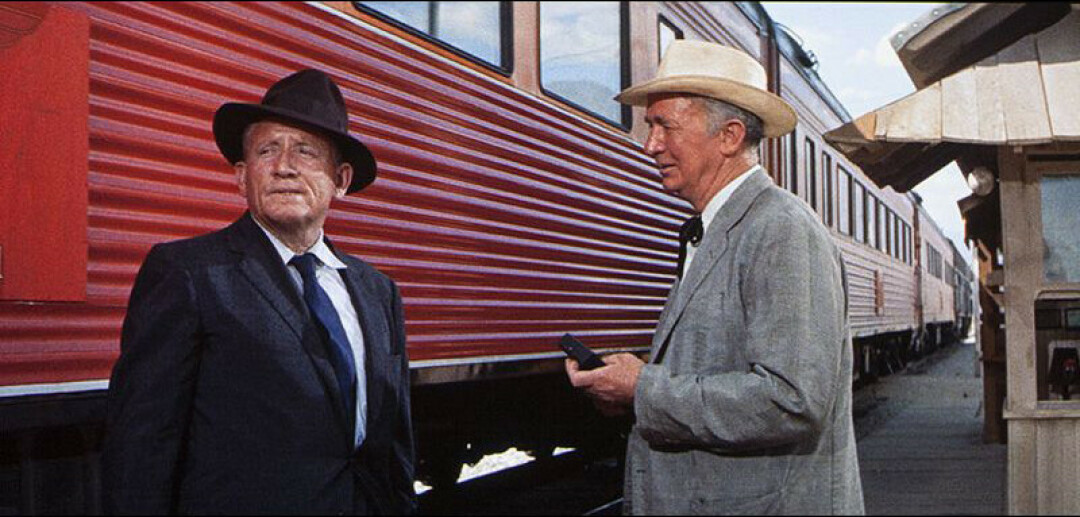A sunny western noir about bigots

Bullies and racists get their due in John Sturges’ great 1955 western noir Bad Day at Black Rock.
Among the very small cast of this odd little film are five Oscar-winning actors, including Spencer Tracy in the starring role, as well as Ernest Borgnine, Walter Brennan (who is one of only three actors to win three Oscars – Jack Nicholson and Daniel Day-Lewis are the other two), Dean Jagger and Lee Marvin (well, it would be another 10 years before Marvin would earn his Oscar for Cat Ballou in 1965 – but he had the stuff in him all along):
Anne Francis is the sole female, apparently in the town and definitely in the movie. Why he is in this crappy place is a mystery (she claims it’s for her brother, who runs the local hotel): The year after this film, she cemented her role in sci-fi history as Alta in Forbidden Planet, and a decade later starred in TV’s Honey West, making her the first eponymous female in a TV series lead role.
I love this spare, taut western noir starring Tracy as John J. Macreedy, a one-armed war veteran coming to pay homage to a dead colleague’s family in some desert backwater town populated by the most paranoid people who ever walked the planet. Right from the start, they don’t like this guy poking around in their dusty town with a terrible secret.
Macreedy is a World War II vet who came back from Europe with a crippled left arm and a mission to present a medal for heroism to the father of a Nissei soldier by the name of Kamoko who died saving Macreedy’s life in Italy.
The movie was based on a 1947 short story called “A Bad Day in Honda.” MGM changed the title for the movie because in 1953 John Wayne had made the 3-D western Hondo, and the studio thought Honda was too close to Hondo.
One must suspend some disbelief in the choice of Tracy as Macreedy because he is a good 20 years too old to be the tough platoon sergeant he is supposed to be. But just let that go and Tracy’s quiet persistence will win you over.

Dore Schary was the head of MGM at the time, and since he took an interest in making movies with social and political messages, he took a personal interest in the production of Bad Day at Black Rock, specifically insisting that only Spencer Tracy had the gravitas to play Macreedy, which even Tracy doubted, feeling the role and story was beneath him.
So the story goes that Schary did two things to convince Tracy to do the movie – first he had Macreedy crippled in one arm, believing that an actor of Tracy’s caliber would not be able to turn down the role of a handicapped person, and then he told Tracy he had sent the script to Alan Ladd, who was eager to do the role.
The film opens with a train making a rare stop in the desert town of Black Rock. Macreedy gets off and makes his way into the dusty town (it was built just for this production, ironically, not far from a WWII Japanese internment camp):
Once he arrives at the town’s only hotel, the locals, led by burly Ernest Borgnine and rangy Lee Marvin, begin needling him, trying to find out why he’s in town and eventually pushing him to violence.
Borgnine and Marvin were made to be bullies – a point both actors had made two years earlier in separate movies – Borgnine as Sgt. “Fatso” Judson in From Here to Eternity and Marvin as Vince Stone, who throws hot coffee on Gloria Grahame’s face in The Big Heat.
Here their menace is more threatening just because our hero seems so vulnerable, and that is a tribute to Tracy’s performance as a lost soul who finds himself through sudden adversity.
One of Marvin’s first lines is to Macreedy, just arrived at the hoteland carrying a suitcase in his good right hand, “You look like you need a hand,” Marvin says.
Robert Ryan’s character, Reno Smith, is the biggest bully of all, orchestrating whatever shenanigans are taking place, and having instigated the murder of the “dirty Jap” farmer that Macreedy has come to see.
Of course, Macreedy has to unravel all this for himself, like a noir gumshoe.
The Criterion Channel refers to director John Sturges (no relation to Preston Sturges) as an “ace genre craftsman,” probably because he went on to do a few blockbuster genre movies that are regarded as classics of their respective genres, including Gunfight at the OK Corral (1957), The Magnificent Seven (1960) and The Great Escape (1963): But he also made Ice Station Zebra in 1968, and I’m still yawning from seeing it at a drive-in many years ago.
Of the 45 movies he directed, Sturges was reportedly happiest with Bad Day at Black Rock for the way everything fell into place with the right cast and location, and the right time, shot in beautiful widescreen Cinemascope, which somehow adds to the haunted feel of the movie. It was the first Cinemascope movie for MGM.
What makes this movie work so well for me is that you know you are in deepest, darkest noir territory, but it’s shot in the brightest of desert sun and glowing widescreen Cinemascope. The darkness is implied. You can’t miss it. Only the film’s resolution at the burned-down Kamoko farm is shot in darkness.
There’s a great scene between Tracy and Ryan, where Tracy is able to needle him and get him to talk about the “dirty Japs” like Kamoko. It’s our first inkling that Ryan’s character is a psychopath. He does reveal that he was the first in line to sign up for the Marines the day after the “dirty Japs” attacked, but he was turned down. Macreedy doesn’t ask why. By then he doesn’t have to.
What he learns is that after being turned down for the Marines, Reno Smith returned to Black Rock, where he and the boys got patriotically drunk and decided to teach Kamoko a lesson for being a dirty Jap.

Spencer Tracy arrives in the desolate town of Black Rock to an unwelcoming committee of locals that include Ernest Borgnine, Lee Marvin and Robert Ryan.
Getting back to Borgnine’s brilliance as a bully, there’s a great yet absurd fight scene in the town cafe.Macreedy walks into the local cafe, takes a seat at the empty counter, orders chili.
Borgnine walks in and informs Tracy he’s sitting on Borgnine’s stool. Tracy moves without comment.
Borgnine sits on the seat and says, “This stool ain’t comfortable.”
“I was afraid of that,” Tracy says, and then, “Suppose you tell me where to sit.”
Borgnine then reaches over and empties hot sauce into his chili.
“I hope that ain’t too much,” he says.
Tracy stands up to face him.
Borgnine brays, “I’m half horse, half alligator. You mess with me and I’ll kick yer lung out.”
He offers to tie one arm, and then both arms, behind his back. Tracy then lands a few well-placed karate chops, a judo flip and pretty much lays out the bullish Borgnine without breaking a sweat.
Those two other Oscar winners – Dean Jagger and Walter Brennan – are sort of peripheral characters, like a Greek chorus commenting on the action.
Jagger is the ineffectual “rumdum” sheriff of Black Rock who says awkward things, like this when first meeting Macreedy: “You move fast for a crip...for a big man.”
Brennan is the town undertaker, known as Doc, who takes great pleasure in watching Macreedy unravel his fellow townsfolk.
At one point Doc tells Macreedy, “I feel for you, but I’m consumed with apathy…Mostly, I try to mind my own business.”
As town puppetmaster, Ryan’s Reno Smith is constantly trying to manipulate his fellow townsfolk. In helping the others to keep needling and pushing Macreedy, he tries to convince him that the guy is not going to give up until he knows the truth about Kamoko.
“I know those maimed guys,” he says. “They put on hair shirts and act like martyrs…This guy is a like a carrier of smallpox and it’s spreading.”
Pretty intense soundtrack from Andre Previn and the MGM Orchestra.
